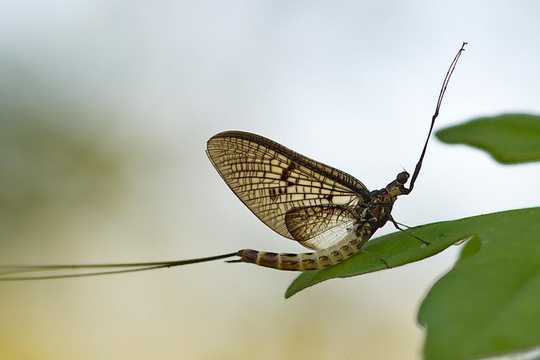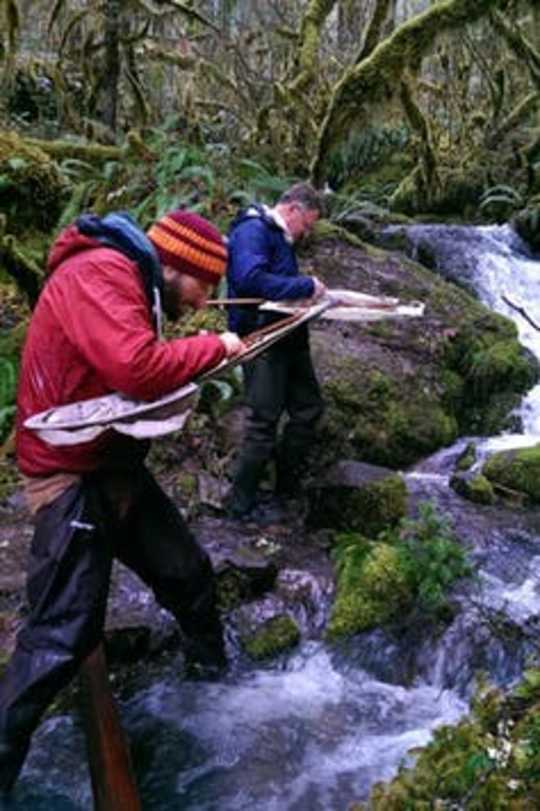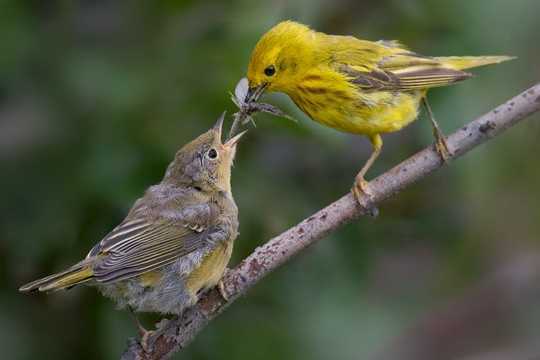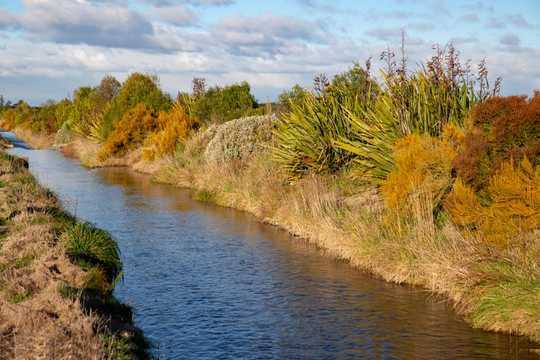 The presence of mayflies and stone flies indicates clean water is nearby. Andrew/flickr, CC BY-NC
The presence of mayflies and stone flies indicates clean water is nearby. Andrew/flickr, CC BY-NC
Experienced anglers recognize that for a trout, the ultimate “steak dinner” is a stonefly or mayfly. That’s why fly fishing enthusiasts will go to extreme lengths to imitate these graceful, elegant and fragile insects.
I share their passion, but for different reasons. As a an entomologist who has studied stoneflies and mayflies for over 40 years, I’ve discovered these insects have value far beyond luring trout – they are indicators of water quality in streams and are a crucial piece of the larger food web. And they are in trouble.
Collecting bugs
I have served as director of the C. P. Gillette Museum of Arthropod Diversity since 1986. The greatest thrill of my career has been collecting and adding mayflies and stoneflies to our collection.
 Boris Kondratieff collecting aquatic insects in Oregon with former student Chris Verdone.
Boris Kondratieff collecting aquatic insects in Oregon with former student Chris Verdone.
To find specimens, I have traveled to pristine streams in every U.S. state, Canada, Mexico, Central America, Brazil, Ecuador, the Arabian Peninsula and Europe. My collecting trips have yielded more than 100 new species of mayflies and stoneflies.
One of my favorites literally fell into my lap as I was beating lush foliage along a pristine stream in southern Oregon during May 2014. The beating sheet is an efficient means of sampling dense, streamside vegetation, where adult insects hide. The sheet itself is made of sturdy canvas stretched over two wooden cross members. A stick is used to knock the insects from the vegetation onto the canvas, where they are collected.
When I saw a large yellow and black insect drop onto my sheet, I knew immediately it was a new stonefly species, previously unknown to science. I was ecstatic. My colleagues and I subsequently described it as Kathroperla siskiyou, after the Siskiyou mountains of southern Oregon.
Mayflies and stoneflies thrive in unpolluted water – a fact my colleagues and I have witnessed firsthand on our numerous expeditions. Not only do we see greater overall abundance of these insects in clean streams, but more diversity of species, as well. In polluted areas, we observe the exact opposite. Without a doubt, the presence or absence of mayflies and stoneflies in a stream is a reliable indicator of the quality of its water.
The role of mayflies and stoneflies in the food chain is fundamental, as well. Immature mayflies and stoneflies consume algae, living plants, dead leaves, wood and each other. In this nymph phase, when they have gills and live exclusively underwater, they are an important food source for many animals further up the food chain, including fish and wading birds. When the mayflies and stoneflies emerge from the water as adults, they are essential food for spiders, other insects such as dragonflies and damselflies, and many kinds of birds and bats.
 Mayflies are on the menu for this hungry fledgling. Keith Williams/flickr, CC BY-NC
Mayflies are on the menu for this hungry fledgling. Keith Williams/flickr, CC BY-NC
Currently, scientists estimate that 33% of all aquatic insects are threatened with extinction worldwide. Many of these species are mayflies and stoneflies. The mayfly species Ephemera compar has already gone extinct in Colorado, and several other species of aquatic insects are threatened in my home state.
Life drains into a stream
Less than 1% of Earth’s water is potable and available for human use. Maintaining water quality has become an ever increasing challenge because of the large number of chemicals people use in everyday life and in commerce. Common contaminants such as sediment, organic enrichment including fertilizers and animal waste and heavy metals are constantly making their way into the waters, as well. Declining water quality is like a police siren alerting humanity to current, ongoing and emerging pollution problems.
 Native plantings along a waterway can reduce storm water runoff. Sheryl Watson/Shutterstock.com
Native plantings along a waterway can reduce storm water runoff. Sheryl Watson/Shutterstock.com
One of my great passions is to enlighten others on how to protect the most valuable natural resource of the planet: streams and rivers. Individually, citizens can make a difference. Storm water is the number one water quality problem nationally. Enhancing and planting riparian buffers – that is, planted areas near streams – can help to prevent precipitation and sprinkler runoff. People can also prioritize using only native plants; decreasing mowing areas; recycling or composting yard waste; using less or no fertilizer; avoiding the use of pesticides; and bagging pet waste. Insisting that environmental laws be enforced and strengthened will also help reduce water pollution.
Without clean water, life on Earth will become difficult or impossible for mayflies and stoneflies, not to mention people.
About the Author
Boris Kondratieff, Professor of Entomology and Curator of the C. P. Gillette Museum of Arthropod Diversity, Colorado State University
This article is republished from The Conversation under a Creative Commons license. Read the original article.
Related Books
Drawdown: The Most Comprehensive Plan Ever Proposed to Reverse Global Warming
by Paul Hawken and Tom Steyer In the face of widespread fear and apathy, an international coalition of researchers, professionals, and scientists have come together to offer a set of realistic and bold solutions to climate change. One hundred techniques and practices are described here—some are well known; some you may have never heard of. They range from clean energy to educating girls in lower-income countries to land use practices that pull carbon out of the air. The solutions exist, are economically viable, and communities throughout the world are currently enacting them with skill and determination. Available On Amazon
In the face of widespread fear and apathy, an international coalition of researchers, professionals, and scientists have come together to offer a set of realistic and bold solutions to climate change. One hundred techniques and practices are described here—some are well known; some you may have never heard of. They range from clean energy to educating girls in lower-income countries to land use practices that pull carbon out of the air. The solutions exist, are economically viable, and communities throughout the world are currently enacting them with skill and determination. Available On Amazon
Designing Climate Solutions: A Policy Guide for Low-Carbon Energy
by Hal Harvey, Robbie Orvis, Jeffrey Rissman With the effects of climate change already upon us, the need to cut global greenhouse gas emissions is nothing less than urgent. It’s a daunting challenge, but the technologies and strategies to meet it exist today. A small set of energy policies, designed and implemented well, can put us on the path to a low carbon future. Energy systems are large and complex, so energy policy must be focused and cost-effective. One-size-fits-all approaches simply won’t get the job done. Policymakers need a clear, comprehensive resource that outlines the energy policies that will have the biggest impact on our climate future, and describes how to design these policies well. Available On Amazon
With the effects of climate change already upon us, the need to cut global greenhouse gas emissions is nothing less than urgent. It’s a daunting challenge, but the technologies and strategies to meet it exist today. A small set of energy policies, designed and implemented well, can put us on the path to a low carbon future. Energy systems are large and complex, so energy policy must be focused and cost-effective. One-size-fits-all approaches simply won’t get the job done. Policymakers need a clear, comprehensive resource that outlines the energy policies that will have the biggest impact on our climate future, and describes how to design these policies well. Available On Amazon
This Changes Everything: Capitalism vs. The Climate
by Naomi Klein In This Changes Everything Naomi Klein argues that climate change isn’t just another issue to be neatly filed between taxes and health care. It’s an alarm that calls us to fix an economic system that is already failing us in many ways. Klein meticulously builds the case for how massively reducing our greenhouse emissions is our best chance to simultaneously reduce gaping inequalities, re-imagine our broken democracies, and rebuild our gutted local economies. She exposes the ideological desperation of the climate-change deniers, the messianic delusions of the would-be geoengineers, and the tragic defeatism of too many mainstream green initiatives. And she demonstrates precisely why the market has not—and cannot—fix the climate crisis but will instead make things worse, with ever more extreme and ecologically damaging extraction methods, accompanied by rampant disaster capitalism. Available On Amazon
In This Changes Everything Naomi Klein argues that climate change isn’t just another issue to be neatly filed between taxes and health care. It’s an alarm that calls us to fix an economic system that is already failing us in many ways. Klein meticulously builds the case for how massively reducing our greenhouse emissions is our best chance to simultaneously reduce gaping inequalities, re-imagine our broken democracies, and rebuild our gutted local economies. She exposes the ideological desperation of the climate-change deniers, the messianic delusions of the would-be geoengineers, and the tragic defeatism of too many mainstream green initiatives. And she demonstrates precisely why the market has not—and cannot—fix the climate crisis but will instead make things worse, with ever more extreme and ecologically damaging extraction methods, accompanied by rampant disaster capitalism. Available On Amazon
From The Publisher:
Purchases on Amazon go to defray the cost of bringing you InnerSelf.comelf.com, MightyNatural.com, and ClimateImpactNews.com at no cost and without advertisers that track your browsing habits. Even if you click on a link but don't buy these selected products, anything else you buy in that same visit on Amazon pays us a small commission. There is no additional cost to you, so please contribute to the effort. You can also use this link to use to Amazon at any time so you can help support our efforts.
























